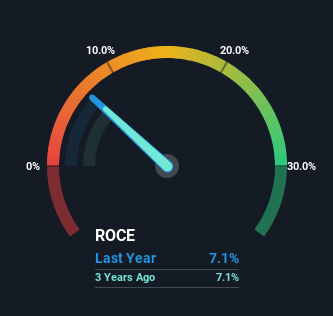- China
- /
- Construction
- /
- SHSE:601186
Here's What's Concerning About China Railway Construction's (SHSE:601186) Returns On Capital

If you're looking for a multi-bagger, there's a few things to keep an eye out for. One common approach is to try and find a company with returns on capital employed (ROCE) that are increasing, in conjunction with a growing amount of capital employed. Put simply, these types of businesses are compounding machines, meaning they are continually reinvesting their earnings at ever-higher rates of return. However, after briefly looking over the numbers, we don't think China Railway Construction (SHSE:601186) has the makings of a multi-bagger going forward, but let's have a look at why that may be.
Understanding Return On Capital Employed (ROCE)
For those who don't know, ROCE is a measure of a company's yearly pre-tax profit (its return), relative to the capital employed in the business. To calculate this metric for China Railway Construction, this is the formula:
Return on Capital Employed = Earnings Before Interest and Tax (EBIT) ÷ (Total Assets - Current Liabilities)
0.071 = CN¥47b ÷ (CN¥1.7t - CN¥998b) (Based on the trailing twelve months to December 2023).
So, China Railway Construction has an ROCE of 7.1%. On its own that's a low return on capital but it's in line with the industry's average returns of 6.8%.
See our latest analysis for China Railway Construction

In the above chart we have measured China Railway Construction's prior ROCE against its prior performance, but the future is arguably more important. If you'd like, you can check out the forecasts from the analysts covering China Railway Construction for free.
What Does the ROCE Trend For China Railway Construction Tell Us?
In terms of China Railway Construction's historical ROCE movements, the trend isn't fantastic. To be more specific, ROCE has fallen from 8.9% over the last five years. However it looks like China Railway Construction might be reinvesting for long term growth because while capital employed has increased, the company's sales haven't changed much in the last 12 months. It may take some time before the company starts to see any change in earnings from these investments.
Another thing to note, China Railway Construction has a high ratio of current liabilities to total assets of 60%. This effectively means that suppliers (or short-term creditors) are funding a large portion of the business, so just be aware that this can introduce some elements of risk. While it's not necessarily a bad thing, it can be beneficial if this ratio is lower.
Our Take On China Railway Construction's ROCE
Bringing it all together, while we're somewhat encouraged by China Railway Construction's reinvestment in its own business, we're aware that returns are shrinking. Unsurprisingly then, the total return to shareholders over the last five years has been flat. Therefore based on the analysis done in this article, we don't think China Railway Construction has the makings of a multi-bagger.
Like most companies, China Railway Construction does come with some risks, and we've found 1 warning sign that you should be aware of.
While China Railway Construction isn't earning the highest return, check out this free list of companies that are earning high returns on equity with solid balance sheets.
New: AI Stock Screener & Alerts
Our new AI Stock Screener scans the market every day to uncover opportunities.
• Dividend Powerhouses (3%+ Yield)
• Undervalued Small Caps with Insider Buying
• High growth Tech and AI Companies
Or build your own from over 50 metrics.
Have feedback on this article? Concerned about the content? Get in touch with us directly. Alternatively, email editorial-team (at) simplywallst.com.
This article by Simply Wall St is general in nature. We provide commentary based on historical data and analyst forecasts only using an unbiased methodology and our articles are not intended to be financial advice. It does not constitute a recommendation to buy or sell any stock, and does not take account of your objectives, or your financial situation. We aim to bring you long-term focused analysis driven by fundamental data. Note that our analysis may not factor in the latest price-sensitive company announcements or qualitative material. Simply Wall St has no position in any stocks mentioned.
About SHSE:601186
China Railway Construction
Engages in the construction business in Mainland China and internationally.
Very undervalued established dividend payer.
Similar Companies
Market Insights
Community Narratives


